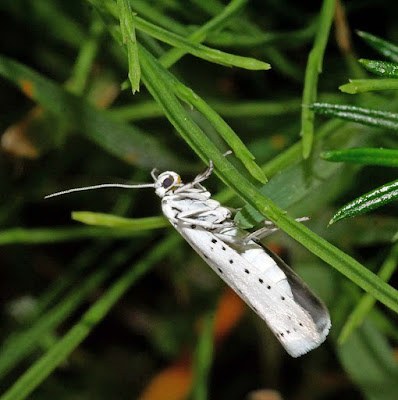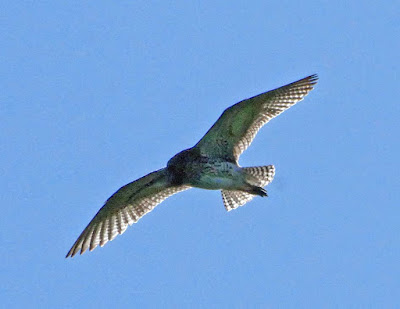We found a population of about 30 broad-leaved helleborines Epipactis helleborine beside the Deerness Valley walk, a disused railway track that has been converted into a pleasant route for walkers and cyclists.
This is an orchid that thrives on woodland edges, in dappled shade. It's pollinated by common wasps Vespula vulgaris, but this was the first time I have seen the pollinators in action.
The flowers emit a scent that attracts the insects, which have short tongues, so they have to push their head right into the flower to reach a pool of nectar. When they do this the orchid's pollinia, which contain all their pollen, stick to the wasp's face. In the photographs above and below (rather blurred, because the light was poor) you can see a wasp arriving after visiting another plant, carrying the white pollinia on its head, ready to pollinate the flower.
Below, you can see a wasp leaving, taking the sticky pollinia with it, attached to its face.
Click here for a very good YouTube video, by Jean Claessens, of the whole process
Thursday, July 30, 2020
Small ermine moth
Small ermine moths usually feed on bird cherry leaves, hereabouts, enclosing whole shoots and even branches in a silken tent, so they can feed safely inside
For the last two years they have fed on spindle bushes in my garden. Spindle Euonymus europaeus is a native hedgerow small tree in Britain, but is rare in the wild here in North East England. It is often grown in gardens, for its attractive seed capsules and vibrant autumn colour.
When the caterpillars are fully fed they crawl down to ground level and spin a silken cocoon on the ground, where they pupate.
They started hatching in my garden in the third week of July.
And here is the newly emerged moth, clad in copy of the ermine trimmed robes worn by their Lordships in the House of Lords.
When the caterpillars are fully fed they crawl down to ground level and spin a silken cocoon on the ground, where they pupate.
They started hatching in my garden in the third week of July.
And here is the newly emerged moth, clad in copy of the ermine trimmed robes worn by their Lordships in the House of Lords.
Labels:
Bird cherry,
Moths,
small ermine moth,
spindle
Friday, July 24, 2020
Curlews
Another curlew breeding season is over, here in the Durham North Pennine foothills.
Their calls, as they fly over my house towards Weardale, are one the the early signs of spring that I always look forward to. This is one of the first birds to arrive, back in late March, in meadows about a mile from my home,
Their long gliding courtship flights, trailing their bubbling calls in their wake, are amongst the most evocative sights and sounds in nature.
I saw these youngsters, still with some downy feathers on their heads, in a meadow about a week ago. Their parents put up a spirited defence against a buzzard that showed too much interest in them, harassing it until it left the scene.
Since then I haven't heard any curlew calls locally, so they must now be on their way to the coast.
Their calls, as they fly over my house towards Weardale, are one the the early signs of spring that I always look forward to. This is one of the first birds to arrive, back in late March, in meadows about a mile from my home,
Their long gliding courtship flights, trailing their bubbling calls in their wake, are amongst the most evocative sights and sounds in nature.
Part of a flock of about a dozen birds, with Weardale in the distance, at the end of the breeding season
Since then I haven't heard any curlew calls locally, so they must now be on their way to the coast.
Labels:
Curlew
Wednesday, July 22, 2020
Whitethroats and blackcaps
One of the unforeseen consequences of coronavirus lockdown, of being confined close to home and going on the same exercise walk almost every day over almost four months, is that I got to know the local migrant songbird population really well.
I first saw this whitethroat on early spring, very soon after it had first arrived, and after finding it and a consort in the same place over several days, was soon able to pinpoint the nest, under a bramble-covered drystone wall.
It was the melodious song of blackcaps - 'the poor man's nightingale' - that first told be they had arrived. Initially they were hard to spot, skulking amongst the spring foliage of trees. But, hearing them from the same places day after day, I soon discovered their favourite song posts and, after a short wait, managed to get much better views.
Labels:
blackcap,
Coronavirus,
lockdown,
Whitethroat
Subscribe to:
Posts (Atom)








































































